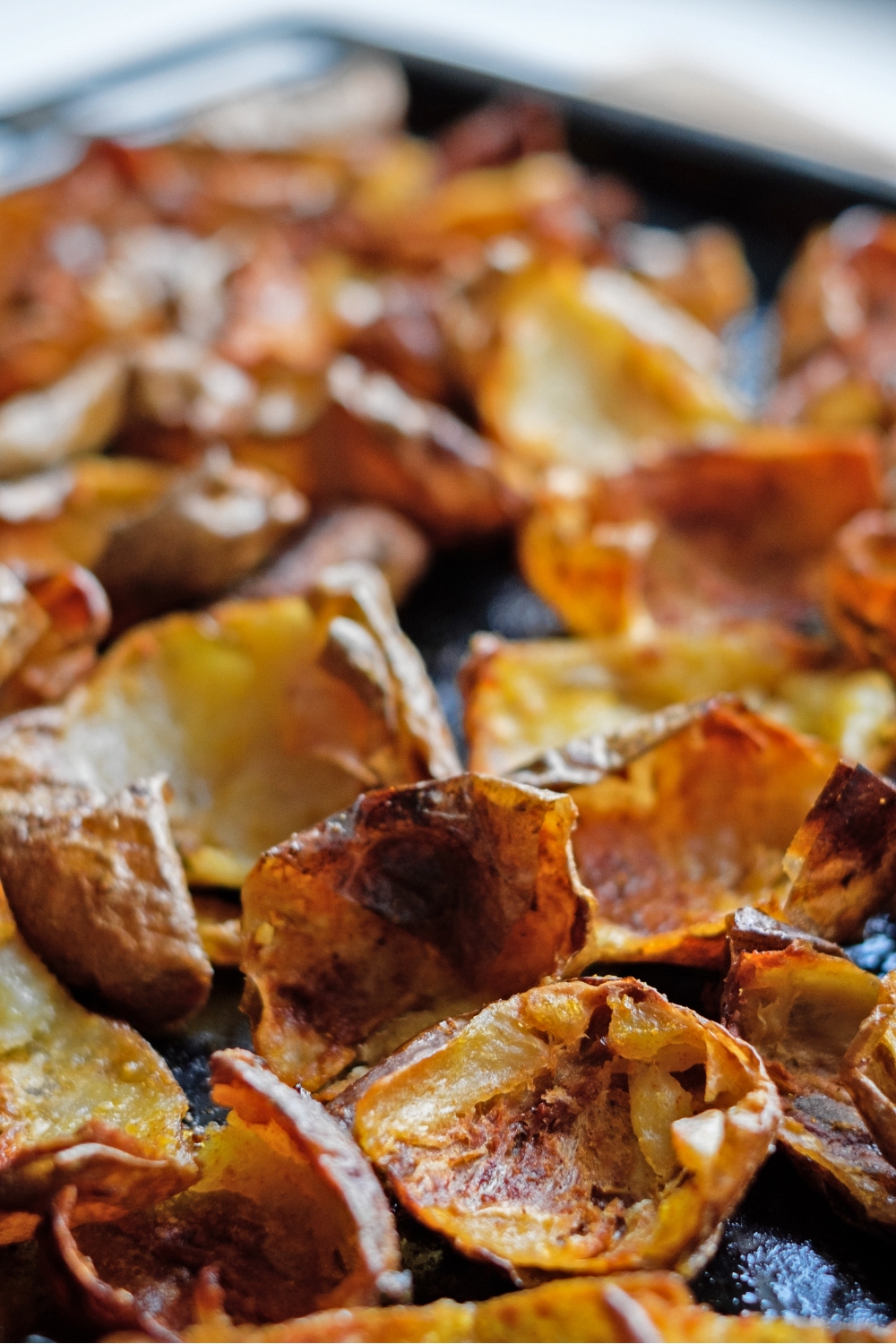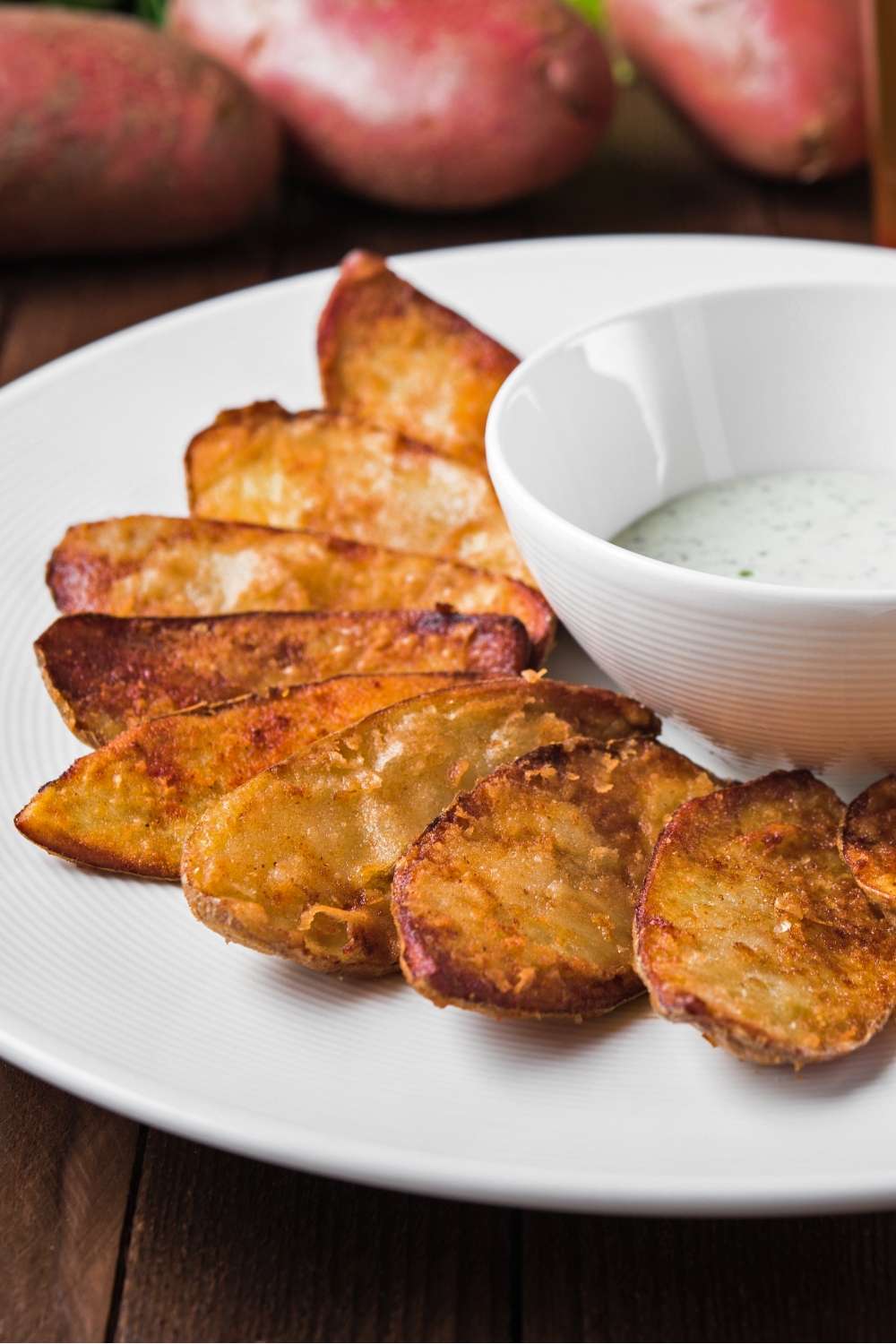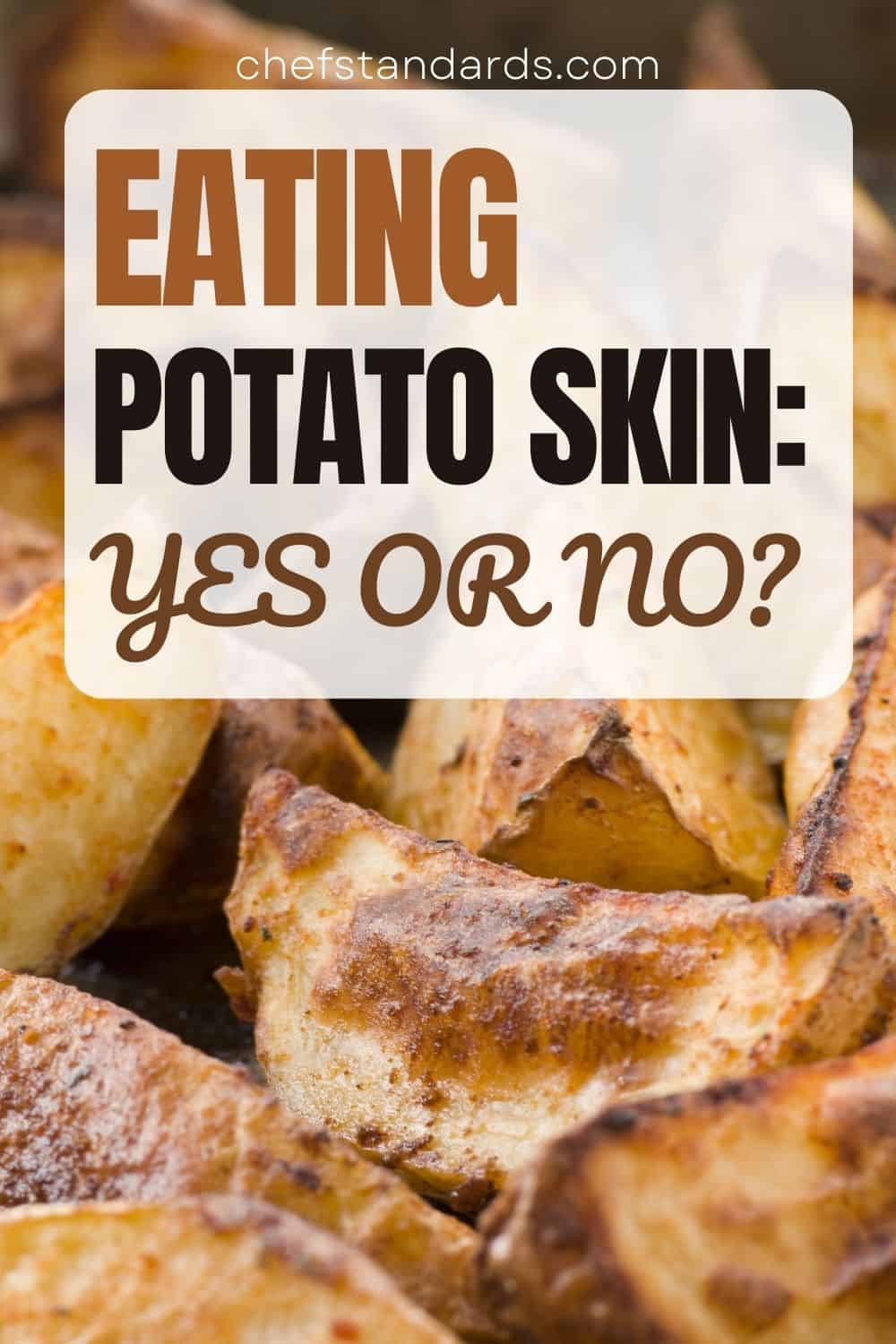Did you know that potatoes saved Irish people from famine back in the 19th century? Yes, this popular staple food played a significant role in one period of history.
However, to this day, it still plays an important role in almost every cuisine in the world due to its extreme culinary versatility.
But, many people still don’t know everything about this root vegetable. We all know that it is versatile, can make you feel full, and is quite nutritious, but whether you can eat potato skin is still a mystery to many.
Surprisingly, the skin is definitely edible, but in some cases, it is not recommended to consume it. Continue reading if you want to find out what those cases are, as well as some other important facts about potatoes and their skin.
Can You Eat The Skin Of a Potato?

As I already said, potato skin is definitely edible, but, as with most types of food, not in all cases.
First, you have to be aware of the fact that this vegetable that starts with P grows under the ground and gets dirty during transport and storage, so it is logical that their skin will not be so clean in the first place.
Because of that, it is essential that you wash and clean the skin properly before you do anything with the skin. It is best to use a vegetable brush and scrub the potatoes under running cold water.
Aside from that, it is also important to remove any spots or sprouts on the spuds with the tip of the knife, as well as any green parts because those contain certain chemicals that can be toxic.
When this is properly done, you can cook the potatoes with the skin on (below you will see the best cooking methods) and enjoy them, as long as you don’t overdo it.
What About Russet Potatoes?
Russet potatoes are one of the most popular varieties in the world, so many people tend to wonder about their edibility and their skin.
Although the skin of raw russet potatoes is more bitter than that of other varieties, once you cook it properly, it changes its flavor for the better and can be very delicious.
Aside from that, the skin is quite thick and rough, but that rough texture actually helps it become crispy when cooked, which can be a nice contrast to its soft and fluffy interior.
Of course, all the rules mentioned above that apply to all types of potatoes also apply to this type, so take that into consideration as well.
I also have to say that the skin of all potatoes is edible, although their flavor profiles are slightly different. Namely, if the skin is thinner, the flavor is milder.
For example, Kennebec potatoes have very thin skin, so many people do not even peel them, sometimes even when making Kennebec fries.
Can You Eat The Skin Of Sweet Potato?
Despite the similar names and the fact that they are both starchy root vegetables, potatoes and sweet potatoes are actually not closely related, i.e., they belong to different plant families and have distinct botanical characteristics.
However, when it comes to the question of eating their skins, things are not so different because the skin of a sweet potato can also be eaten if it is not green and hasn’t sprouted, and if you clean it properly.
Also, it is even healthier to consume skin alongside sweet potatoes because it is rich in vitamin A. Actually, if you consume 100 grams of baked sweet potatoes with the skin on, you will get your the recommended daily dose of vitamin A. (1)
Of course, you also have to know the spoilage signs of sweet potatoes, so that you can be 100% on the safe side.
What Are The Benefits Of Eating Potato Skin?

Not only can you eat the skin of potatoes if you prepare and cook them properly, but it will provide you certain benefits as well, as it is even healthier to eat unpeeled cooked potatoes.
So, let’s take a look at some of the health benefits of eating potato skin:
• Great Source of Fiber: It is a rich source of dietary fiber. The skin of the potato contains both soluble and insoluble fibers, which are great for your digestive health.
Aside from that, the fiber also makes you feel full, which can be beneficial for weight management.
• Vitamins: You might be surprised, but potato skin actually contains a decent amount of vitamin C, as the skin of one whole potato can provide you with 8 grams vitamin C.
It is also a great source of B vitamins, including vitamins B5, B6, and B3 (also known as niacin. It contains a decent amount of thiamine (B1), riboflavin (B2), and folate (b9) as well. In general, B-vitamins are good for the heart, brain, and nervous system.
• Minerals: Decent amounts of potassium and manganese can also be found in potato skin. The skin is also a good source of magnesium, calcium, iron, zinc, copper, and phosphorus.
These vitamins can provide you with great benefits for stronger and healthier bone structures, among many others.
• Flavonoids: There is a certain amount of flavonoids in potato skin, and they are primarily known for their ability to fight free radicals and regulate cellular activity.
However, the most representative type of flavonoid in the skin of the potato is quercetin, which is known for its anti-allergy properties.
• Choline: Choline is a type of nutrient mostly found in eggs, but surprisingly, potato skin also contains it in certain amounts.
It is very important for a healthy brain and nervous system, which are responsible for regulating memory, mood, muscle control, and other functions.
Other Advantages of Keeping Potato Skin
Aside from the benefits directly related to health, there are also some other advantages of keeping the skin attached to the potato.
First, by avoiding peeling potato skin, you will reduce food waste. This doesn’t only mean that you reduce the waste of the skin, but also that tiny part of potato flesh right beneath it.
Namely, when you peel the skin, there is not a high amount of flesh wasted when you look at just one potato. But when you are dealing with a large batch, the amount of flesh multiplies, and a lot of it goes to waste.
Aside from that, potato skin is quite versatile, i.e., you can use it alongside potatoes in various types of dishes, including roasted potatoes, stuffed potatoes, etc. But you can also use the skin alone in a lot of different ways, which we will discuss below.
Are There Any Safety Concerns?
There are certain safety concerns when it comes to consuming potato skin. Even more so because it is a part that is constantly exposed to external factors, unlike the flesh of the potato.
First, the most obvious danger is dirt, which can contribute to many problems, including pests, bacteria, and various unwanted microorganisms. Proper cleaning is therefore a MUST.
If you bought your potatoes from the grocery store, they are most likely treated with pesticides, which are the chemicals used to protect crops from pests and diseases.
However, these chemicals can be very dangerous to your health, so store-bought potatoes are not a good choice if you want to enjoy the skin of the potato.
Instead, you should look for organic potatoes grown without synthetic pesticides.
Entirely fresh potato skin contains a certain amount of solanine, a toxin that potatoes use as a defense mechanism to deter animals from eating them.
But, the amount of solanine is very low and can not do any damage unless you really overdo eating potato skins.
But if potatoes develop a greenish tint, the amount of solanine will increase rapidly. So if you consume it like this, there is a high chance that it will lead to digestive issues, headaches, and in extreme cases, it can even be toxic.
This greenish tint is caused by prolonged exposure of potatoes to direct sunlight, so it is essential to store them in a dark place. The formation of solanine can also be enhanced by moisture, excessive temperature, pest infestation, sprouting, and injury.
What Are The Ways To Cook Potatoes With Skin On?

If you clean and prepare your potatoes properly, cooking them with their skin on is an excellent way to use all the benefits that the whole potato offers. So, let’s look at some ways to use potatoes with the skin on.
Baked Potatoes
Baking potatoes whole is one of the most popular ways to cook them, and it is quite healthy as well, especially when compared with some other methods, like grilling or roasting.
Preheat your oven to around 400°F (200°C). Wash the potatoes and pat them dry. Pierce each potato a few times with a fork to allow the steam to escape. Rub the skins with olive oil and sprinkle with salt.
Place the potatoes directly on the oven rack or on a baking sheet, and bake for approximately 45-60 minutes, or until the skin is crispy and the inside is tender.
Serve them with your favorite toppings such as butter, sour cream, cheese, chives, or bacon.
Unpeeled baked potato definitely tastes richer than peeled ones, and skin adds texture and bite as well, which is a perfect combination. In case you end up with some leftovers, you can store baked potatoes and other cooked vegetables in the fridge for 3 to 4 days, as recommended by the USDA.
Roasting
It is a less healthy option, but a very popular and delicious method.
Start by scrubbing the potatoes thoroughly to remove any dirt. Then, cut them into evenly sized pieces, toss them with olive oil, salt, pepper, and your choice of herbs or spices, and spread them out on a baking sheet.
Roast in a preheated oven at around 425°F (220°C) for 30-40 minutes, or until they are golden brown and crispy on the outside. The skin will become crispy and flavorful, providing a delightful contrast to the soft interior.
Grilling
Potatoes can be grilled with the skin on, which imparts a smoky and slightly charred flavor. To do this, slice the potatoes into wedges or thick slices. Toss them with olive oil, salt, and any desired seasonings.
Preheat your grill to medium-high heat and place the potato slices directly on the grill grates. Cook for about 10-15 minutes, flipping them occasionally, until they are tender and have grill marks.
The skin will become slightly crispy and add a delightful smokiness to the potatoes.
Potato Salad
Potato salad is definitely one of my favorites, especially when I make it with the skin on because it adds a unique texture and pleasant flavor.
Simply boil whole or halved potatoes until they are tender but still firm. Once cooled, chop the potatoes into bite-sized pieces.
Mix them with your preferred combination of ingredients such as mayonnaise, mustard, herbs, diced onions, celery, pickles, and seasonings.
Enjoy!
Mashed Potatoes
Yes, you can even make mashed potatoes with the skin on! Boil the potatoes until tender, then drain and let them cool slightly.
Leaving the skin intact, mash the potatoes with a potato masher or fork until smooth. Alternatively, you can use a potato ricer.
Add butter, milk, or your preferred dairy/non-dairy options, and season with salt and pepper. The skin will add a rustic texture to the mashed potatoes.
Can You Do Anything With The Peels?
If you want to enjoy the skin on its own, there are a few ways to do that and I will reveal to you the most delicious ones.
• Bake Them: If your goal is to make crispy snacks, you can bake the peels. After washing the potatoes thoroughly, cut the skins into strips or small pieces.
Toss them with oil, salt, and spices of your choice, then bake them in a preheated oven at around 400°F (200°C) until crispy.
• Deep-Fry Them: This is actually the unhealthier option, but in my opinion, a more delicious alternative to baking.
If you want to make flavorful and crunchy crispy snacks, deep-fry them until golden brown. They will have a similar flavor and texture to one of the most eaten foods in the world, French fries.
Serve them with sour cream and chives and enjoy.
• Broth or Stocks: You can also use them to enhance the flavor of homemade broths or stocks.
Save the potato skins and add them to a pot along with vegetable scraps, herbs, and spices. Cover with water and simmer for an extended period to extract the flavors. Strain the broth and use it as a base for soups, stews, or sauces. Do the same when making beef consomme.
You can also freeze the potato soup for later if you don’t want to consume it right away.
Final Verdict
So, can you eat potato skin? Yes, it is safe to eat potato skin in moderation. However, you have to note a few important facts:
• Look for organic potatoes, as they are not treated with pesticides.
• Clean the potatoes properly and get rid of any spots or sprouts.
• Avoid potatoes with a greenish tint, as it contains high amounts of the toxin known as solanine.
• Always store the potatoes in a dark place, as direct sunlight and excess temperature can increase the amount of toxins.
• Always cook the potatoes with their skin on; if you want a healthier version, boil or bake them instead of frying.
• Do not toss the peels because you can use them as well.
Sources:
1. MedicalNewsToday (2019), https://www.medicalnewstoday.com/articles/281438, accessed 19 July 2023

